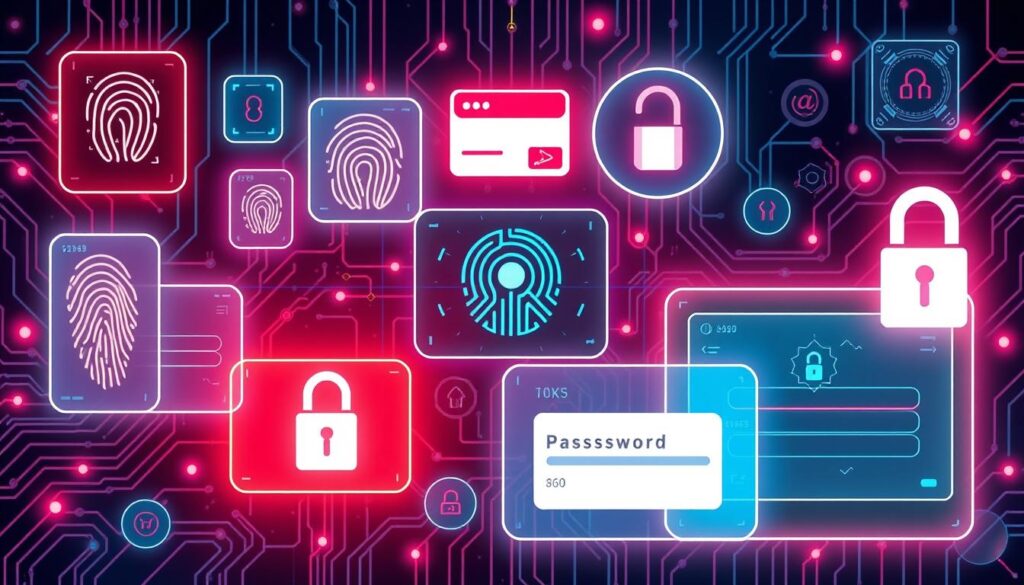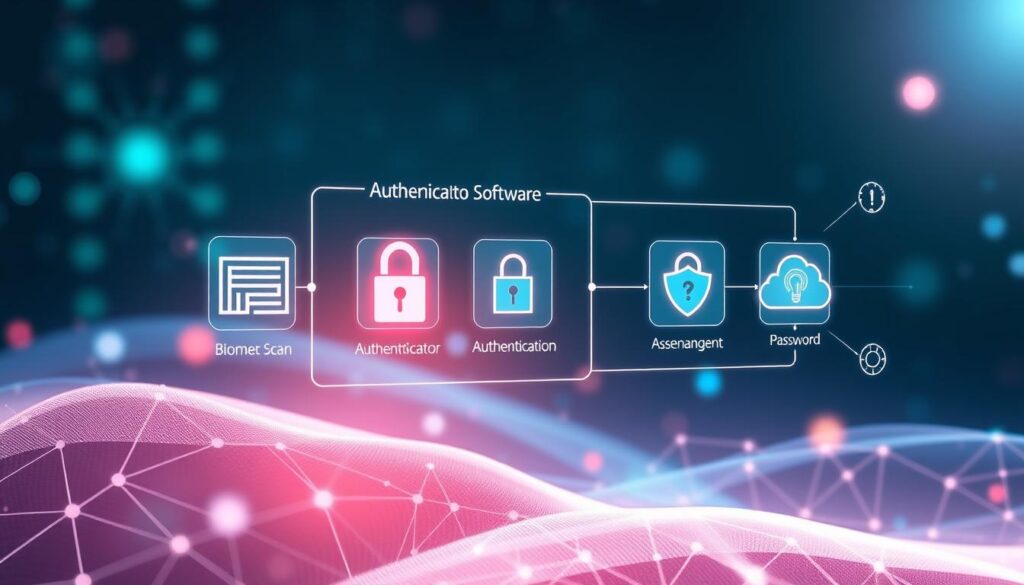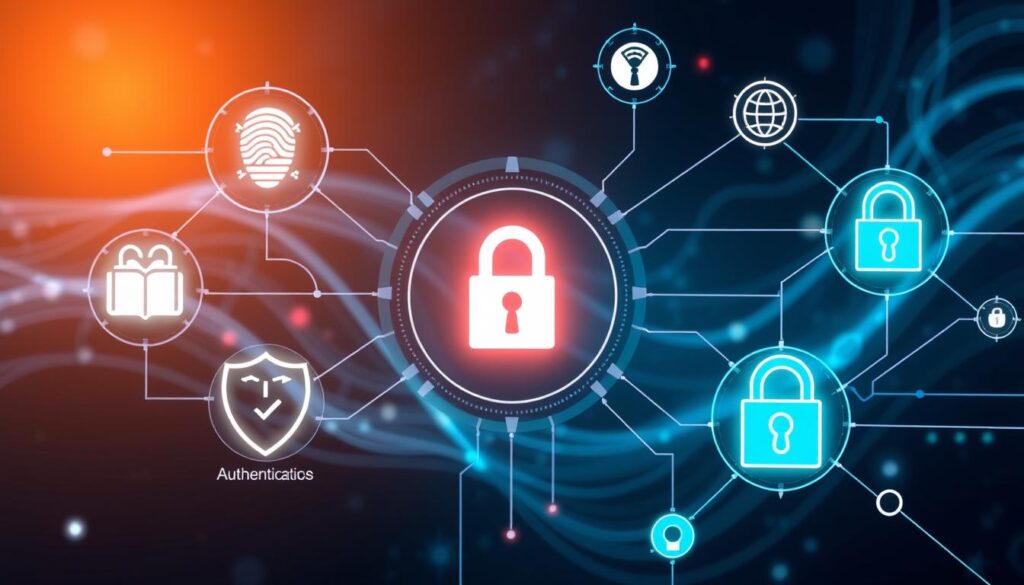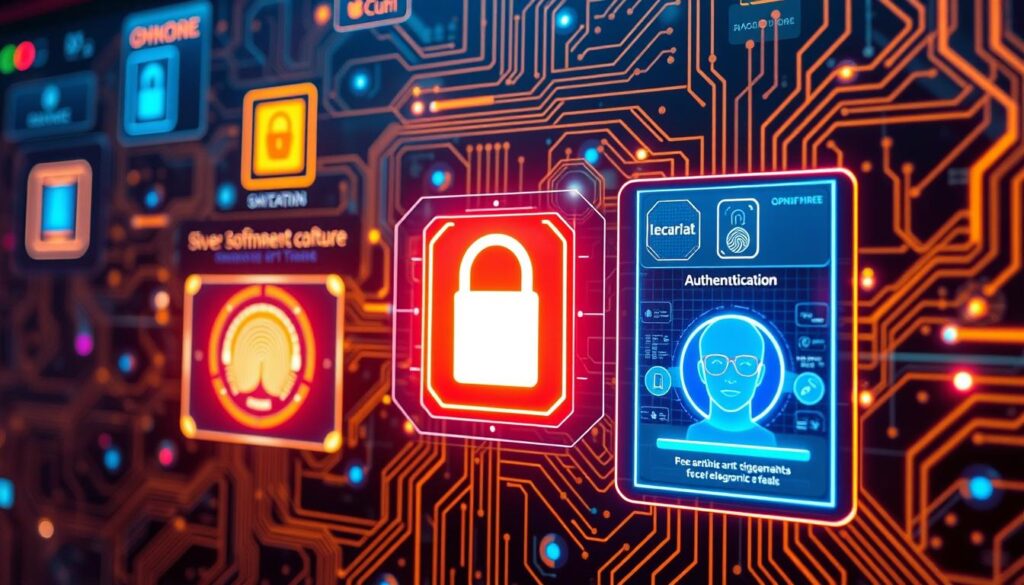FTC disclaimer: This post contains affiliate links and I will be compensated if you make a purchase after clicking on my link.
Are you worried about your online account security? Look into authentication software. These tools protect your digital identity and keep your info safe. But, with many choices, picking the right one can be hard.
This guide will show you the best authentication software. We’ll look at their features, good points, and bad points. You’ll learn about new ways to keep your digital world safe. This is great for both small businesses and personal users.
Key Takeaways
- Discover the top-rated authentication software solutions for securing your digital assets.
- Understand the different types of authentication methods and how they can enhance your overall security.
- Learn how to choose the right authentication software based on your specific needs and requirements.
- Explore the benefits of implementing authentication software in your organization or personal life.
- Stay ahead of the curve with insights into the future trends in the authentication software industry.
What is Authentication Software?
Authentication software is key in checking who you are before you can get into systems or data. It’s more than just a username and password. It uses different ways to make sure you’re who you say you are.
Types of Authentication Methods
The main ways to check who you are include:
- Passwords – the old way to prove you’re you, but they can be hacked.
- One-Time Passcodes (TOTP or OTP) – codes that change fast, adding more security.
- Biometric Authentication – uses things like fingerprints or faces to confirm your identity.
- Security Keys – small devices that make a code just for you, or use secret codes for access.
Using these methods together in a multi-factor authentication (MFA) process makes your Identity and Access Management (IAM) stronger. This makes your accounts and data much safer.

“Authentication software is essential for businesses today, as it helps protect against unauthorized access and data breaches.”
Strong authentication helps keep your business safe from hackers. It makes sure only the right people can get into your systems and data. This is very important in places like banks, hospitals, and government offices, where keeping data safe is a top priority.
Top Authentication Software Solutions
Choosing the right authentication software is key to protecting your digital identity. Leading Identity Management Platforms offer various solutions. Let’s look at the pros and cons of top Top Authentication Software providers.
Okta Identity Management
Okta is a top Identity Management Platform. It offers customizable identity and access management. Prices start at $3 per user per month, making it affordable for all sizes.
Microsoft Authenticator
Microsoft Authenticator is a free MFA app for Android, iOS, and Wear OS. It’s easy to use and secure. It’s perfect for individuals and small businesses.
VMware Workspace One Access
VMware Workspace One Access is a full Identity Management Platform. It has MFA, SSO, and device management. It’s great for big companies with complex IT needs.
Auth0 by Okta
Auth0, now part of Okta, is easy for developers. It offers free and paid plans. It’s good for all kinds of businesses.
OneLogin
OneLogin is a cloud-based Identity Management Platform. It has MFA, SSO, and user provisioning. Prices start at $2 per user per month, ideal for small to medium businesses.
Ping Identity PingOne
Ping Identity PingOne is for big companies. It has advanced security like adaptive MFA. Prices start at $3 per user per month.
SecureAuth
SecureAuth is a full Identity Management Platform. It has MFA, SSO, and identity governance. It’s flexible for all sizes and industries.
BIO-key PortalGuard
BIO-key PortalGuard focuses on biometric authentication. It offers fingerprint, face, and voice recognition. Prices start at $3 per user per month.
CyberRes NetIQ
CyberRes NetIQ is for big enterprises. It has identity and access management tools. It’s scalable and has a lot of features.
When picking Top Authentication Software, think about security, scalability, integration, and price. This ensures the right fit for your needs and budget. Knowing the pros and cons helps make a smart choice for your digital security.
Choosing the Right Authentication Software
When picking authentication software for your business, it’s key to look at what it offers. Check if it meets your security needs and fits your budget. Look at how it collects data, backs up information, and works with your systems.
Also, see if it can be set up easily and supports different ways to log in, like biometrics.
To find the best match, here are important things to check when evaluating authentication solutions:
- Cost Structures: Know how different services charge. Some charge per use, others have fixed rates. Think about how costs might change as your users grow. Look at free options like Google and Microsoft’s services, which might save money over time.
- Security Features: Find software with strong security. It should support multi-factor authentication (MFA) with options like biometrics, SMS, and email. Check its encryption, password protection, and access controls.
- Integration and Deployment: See if the software works well with your current systems. Make sure it’s easy to set up, whether it’s cloud-based or on-premises.
- User Experience: Choose software that’s easy to use. This makes logging in smoother for your team and customers.
- Scalability and Flexibility: Pick a solution that can grow with your business. It should handle more users and new login methods.
By looking at these points, you can select the authentication software that meets your authentication software for businesses needs. This ensures your business is secure, cost-effective, and easy to use.

“Choosing the right authentication software is key to protecting your business and its data. Take time to carefully review your options to find the best fit for your security needs and budget.”
Benefits of Implementing Authentication Software
Using authentication software brings many good things. It makes your security better, cuts down fraud, and boosts productivity. Let’s look at the main benefits of adding this software to your work.
Improved Security
One big plus is better security. It checks who you are with things like passwords and biometrics. This keeps your important data safe from hackers.
Reduced Fraud
It also fights fraud well. By checking who’s logging in, it stops bad guys from getting in. This keeps your money safe and your customers’ trust too.
Compliance
Many rules need strong security checks. This software helps you follow these rules, like HIPAA or GDPR. It shows you care about keeping data safe and following the law.
Productivity Gains
It can even make your team work better. It makes logging in easier, so people can do their jobs without hassle. Plus, it makes things like single sign-on work better, making everyone’s day easier.
In short, using authentication software is a smart move. It makes your security strong, fights fraud, helps you follow rules, and makes your team work better. It’s a win-win for your business.

Best Authentication Software: Top Picks & Reviews
Okta Identity Management
Okta is a top identity and access management (IAM) platform. It’s known for its flexibility, automation, and wide integration. It makes user login and access easy across cloud and on-premises apps.
Okta helps organizations manage digital identities safely. It has features like single sign-on, multi-factor authentication, and user lifecycle management. This makes it a top pick for companies looking for a complete Top Authentication Software solution.
Microsoft Authenticator
Microsoft Authenticator is a well-liked Authentication App. It makes logging into Microsoft accounts easy and secure. It also has password management and biometric authentication for extra security.
The app supports push notifications, one-time codes, and works with the Microsoft Authenticator browser extension. This Microsoft Authenticator app is great for users who want to protect their digital identities.
Okta and Microsoft Authenticator are often at the top in Authentication App Reviews. They offer many features and benefits for both businesses and individuals.

Implementing and Managing Authentication Software
Putting authentication software into your systems needs careful planning. You must set up single sign-on (SSO) policies. Also, you need to add users and apps, and link it with identity and mobile management.
Deployment and Integration Strategies
When deploying authentication software, start with a phased approach. This is good if users are used to hardware tokens. It lets them keep using hardware while they get used to the new authentication software solutions.
Integrating authentication software with your systems is key for a smooth experience and better security. Choose solutions that work well with your SSO tools and identity management. This makes access easier and helps keep an eye on user activities.
To manage authentication software well, make clear policies for user setup, access, and security checks. Update these policies often to keep up with new threats and user needs. Train your team on using the authentication software so they can help your users.
| Feature | Benefits |
|---|---|
| Single Sign-On (SSO) | Streamlines user access, reduces login friction, and enhances security by centralizing authentication. |
| Multifactor Authentication (MFA) | Adds an extra layer of security by requiring multiple verification methods, such as passwords, biometrics, or push notifications. |
| Access Control | Enables granular control over user permissions and resource access, ensuring appropriate levels of security. |
| User Provisioning | Automates the process of creating, updating, and deactivating user accounts, improving efficiency and security. |
By planning and executing your authentication software deployment and integration well, you can make your security better. You’ll also make things easier for your users and better manage access.
Addressing Security Concerns with Authentication Software
Authentication software helps keep your system safe by checking who’s logging in. But, there are still worries like data privacy and following rules. It’s important to use the right practices and settings to keep your system secure.
Data privacy is a big worry. Things like passwords and biometric data need to be kept safe. Make sure your software uses strong encryption to protect this information.
Following rules is also key. You might need to follow laws like GDPR or HIPAA. Check if your software meets these rules to stay legal.
- Enforce a minimum password length of 8 characters to prevent weak credentials.
- Store passwords using secure cryptographic techniques to safeguard user data.
- Require re-authentication for sensitive features to mitigate CSRF and session hijacking.
- Implement strong transaction authentication for critical operations.
- Use generic error messages to prevent user ID and password enumeration attempts.
It’s also important to fix any weak spots in your system. Things like guessing passwords or phishing attacks can be a problem. Keep your system updated to avoid these issues.
| Metric | Recommendation |
|---|---|
| Minimum Password Length | 8 characters |
| Maximum Password Length | At least 64 characters |
| Password Storage | Secure cryptographic techniques |
| Re-authentication for Sensitive Features | Required to mitigate CSRF and session hijacking |
| Transaction Authentication | Implement strong authentication for critical operations |
| Error Messages | Use generic messages to prevent user ID and password enumeration |
By tackling these security issues, you can make your system safer. This protects your users’ data and keeps you in line with the law.
Future Trends in Authentication Software
The digital world is changing fast. The authentication software industry is getting ready for big changes. Experts say we will see new ways to keep our digital lives safe.
Passwordless authentication is becoming more popular. Instead of passwords, we use biometrics like fingerprints and facial recognition. Security tokens and one-time passwords are also being used more.
Behavioral biometrics are a new tool for keeping us safe. They watch how we type and move the mouse. This way, they check who we are all the time, not just once.
- Passwordless Authentication: Biometrics, security tokens, magic links, and one-time passwords (OTPs) are gaining popularity.
- Behavioral Biometrics: Ongoing monitoring of user behavior for continuous authentication.
More people are using multi-factor authentication (MFA). MFA uses biometrics and other methods to keep us safe. It makes sure we are who we say we are without making things too hard.
Social login and single sign-on (SSO) are getting better too. They make logging in easy and safe. But, we have to trust the companies that help us log in.
Decentralized identity solutions are coming. They let us control our digital selves better. They make it harder for hackers to get our info. But, they are still new and need to get better.
Adaptive authentication is another big change. It uses what we do and where we are to decide how safe we need to be. It tries to keep us safe without making things too hard.
The world of digital security is always changing. The authentication software industry is ready to meet these new challenges. This will help us all stay safe online.
Authentication Software for Small Businesses
As a small or medium-sized business owner, you know the importance of security and cost. There are Authentication Software for SMBs made just for you. These tools are easy to use, affordable, and simple to manage. They are perfect for businesses with limited IT resources.
Authentication software is key for Small Business Security. It keeps your data safe and protects your digital assets. These Affordable Authentication Solutions offer features like password management and multi-factor authentication. They give your business the security it needs without costing too much.
Looking to improve employee access or password sharing? The top authentication software for small businesses has what you need. By choosing the right tools, you can keep your digital world safe from hackers and unauthorized access.
Top Authentication Software for Small Businesses
- Bitwarden: A highly secure and user-friendly password manager with a free plan for small businesses.
- NordPass Business: Offers password hygiene alerts, emergency access options, and email masking to protect your team’s credentials.
- Dashlane for Business: Provides a reporting dashboard to monitor password health and encourage strong password practices among employees.
- RoboForm for Business: Delivers diverse form-filling options, emergency access, and comprehensive password security reports.
- Keeper Business: Allows you to generate compliance reports showcasing employee password usage and hygiene levels.
- LogMeOnce: Offers unique features like geofencing and a free service tier, making it a versatile choice for small businesses.
- Sticky Password for Teams: Stands out for its desktop app integration and local-only storage options for enhanced data privacy.
Investing in the right Authentication Software for SMBs is a smart move. It keeps your small business safe, protects your data, and lets your team work efficiently. All this without spending too much. Start improving your Small Business Security today.
Authentication Software and Compliance
In today’s world, companies in many fields must follow strict rules to keep data safe. Rules like NIST, HIPAA, PCI DSS, and GDPR require strong ways to stop unauthorized access and data theft.
Authentication software is key in helping companies follow these rules. It helps keep data safe and avoids big fines for not following rules.
- NIST (National Institute of Standards and Technology) guidelines require the use of multi-factor authentication to protect sensitive information.
- HIPAA (Health Insurance Portability and Accountability Act) mandates the implementation of secure authentication mechanisms to safeguard protected health information (PHI).
- PCI DSS (Payment Card Industry Data Security Standard) stipulates the use of strong authentication controls to protect credit card data.
- GDPR (General Data Protection Regulation) emphasizes the importance of robust authentication measures to safeguard personal data of EU citizens.
Authentication software has many features like single sign-on (SSO), centralized identity management, and multi-factor authentication (MFA). These help companies meet rules. They make it easier for users to log in and keep data safe from unauthorized access.
For companies dealing with complex rules, getting the right authentication software is smart. It helps protect their work, keeps data safe, and avoids big fines.
Best Practices for User Adoption and Training
Getting your team to use authentication software well needs good adoption and training. Here are some tips to help your team accept and use the new tech smoothly.
- Clear Communication: Make a clear plan to teach users about the authentication software. Talk about its benefits and answer any worries. Keep users updated and trained to keep them interested.
- Intuitive Interfaces: Make the authentication software easy to use. This means it should be simple and straightforward. Make hard tasks easier and guide users well to improve their experience.
- Comprehensive Training Materials: Create detailed training stuff. This includes tutorials, guides, and videos. This helps users learn and use the authentication software well.
- Incentives for Adoption: Offer rewards and recognition for using the authentication software. This boosts user interest and makes using it a team effort.
- Effective Change Management: Have a plan for changing to the new authentication software. This includes solving problems and giving ongoing help and training.
By following these tips, you can make sure your team uses the authentication software well. This will help keep your organization safe and productive.
| Key Metric | Importance |
|---|---|
| User Adoption Rate | Shows how many users are using the software, showing if it’s working well in your team. |
| User Retention Rate | Checks if users keep using the software, showing if training and onboarding are good. |
| Customer Satisfaction | Measures how happy users are with the software. Happy users use it more and tell others about it. |
“Successful user adoption of authentication software is essential for maximizing its impact and ensuring a seamless transition within the organization.”
Conclusion
Authentication software is key in today’s cybersecurity world. It adds extra protection beyond just passwords. It helps organizations stay safe, fight fraud, and meet rules.
It also lets employees safely get to the resources they need. This guide helps pick, use, and manage authentication software. It keeps digital stuff safe and keeps businesses running.
Tools like Okta and Microsoft Authenticator are big in Identity Management. Solutions like Hanko.io and Zitadel are leading in Secure Access. The fight against cybercrime and data breaches is getting more advanced.
Using the best Cybersecurity Best Practices keeps important info and systems safe. This is true even as threats keep changing.
The success of authentication software depends on a full plan. It must think about user needs, IT setup, and rules. Knowing the latest in this field helps make smart choices. It keeps your digital world safe and earns trust from others.











